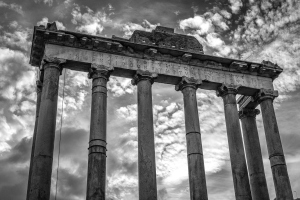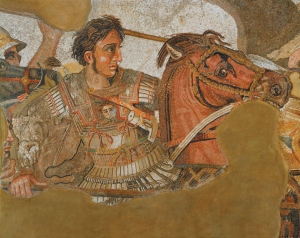The short answer to the question is, nothing. But let One Thing after Another explain why it is asking the question in the first place.
In the aftermath of the Paris attacks that took place on November 13, Niall Ferguson wrote the following opinion piece that appeared in the Boston Globe, entitled “Paris and the Fall of Rome”:
Ferguson argues that the attacks herald the collapse of contemporary European civilization. The Europe of today, he claims, is following the same path as Rome on the way to destruction: “As its wealth has grown, so its military prowess has shrunk, along with its self-belief. It has grown decadent in its shopping malls and sports stadiums. At the same time, it has opened its gates to outsiders who have coveted its wealth without renouncing their ancestral faith.” He likens the great numbers of Syrian refugees to the Völkerwanderung, the great migration of barbarian peoples that swamped the Roman Empire and destroyed it. He points out that while the vast majority of Muslims currently living in Europe are neither violent nor terrorists, they hold views that are extremely difficult to reconcile with the principles of “modern liberal democracies.” For that reason, “it is . . . remarkably easy for a violent minority to acquire their weapons and prepare their assaults on civilization within these avowedly peace-loving communities.”
Ferguson was originally trained as an academic economic historian. He has since written books on a variety of topics (including a biography of Henry Kissinger that was published this year), many of which are aimed at a more popular audience. He has also become a journalist and an opinion-maker. The combination of these roles has turned him into something of a public intellectual. The position of public intellectual is an honorable one, and in this context, one is reminded of the Victorian sages, particularly John Stuart Mill, of whom One Thing after Another is particularly fond. The problem with assuming the role of sage, though, is that it is extraordinarily difficult to express an informed opinion about everything. As Ferguson himself implies in “Paris and the Fall of Rome,” he is not an expert on late Roman history. And Edward Gibbon’s History of the Decline and Fall of the Roman Empire (1776-1789), to which Ferguson repeatedly adverts, does not accord with the most current scholarship on Rome’s demise.
With his constant references to Gibbon, Ferguson seems to indicate that 5th-century Rome was overborne from without because it was rotten within. He mentions the work of contemporary historians Bryan Ward-Perkins and Peter Heather, but he does not do justice to their findings because they do not necessarily support his argument. Heather’s most important recent book, The Fall of the Roman Empire: A New History (2005) argues that the Rome which entered the 4th century was not the decadent and disintegrating society that Gibbon portrays. Instead, it was strong, stable, and full of vigor. For centuries, it had managed its frontiers with a combination of brute force and diplomacy. Any barbarians who settled within the frontier did so on Rome’s terms. Yet starting in the late 4th century, for a host of reasons that were mainly outside its control, Rome began experiencing great difficulties in asserting control over the Germanic peoples who sought to enter the empire so as to escape the Huns. Such a picture does not accord with Ferguson’s representation of late Rome or contemporary Europe. It is not hard to see why. Fifth-century Rome is not the Europe of 2015. Syrian refugees do not resemble the Völkerwanderung. And Muslims living in Molenbeek are not like the Goths of late antiquity. In other words, as an analogy, Ferguson’s formulation is problematic because historical analogies are problematic in general. If anything, Ferguson’s statements are more metaphor than analogue, and the employment of metaphors themselves entail a number of dangers.
Indeed, if we were so inclined, we could look to Roman history for a completely different “lesson” with contemporary applicability. The reasons for Rome’s fall to which Ferguson refers have long been disputed—by Gibbon, Heather, and a host of others. What is not disputed is that during the period of its greatest expansion under the republic, Rome was an inclusive community that extended citizenship and other privileges on a huge scale to recently conquered peoples. One might be tempted to make the case that Rome promoted a model for assimilation that could have contemporary uses. In other words, by way of analogy, this example might entice one to support a very different set of policies from the ones Ferguson advocates. And one would be wrong because Rome was not a modern liberal democracy. Its “inclusiveness” was not the sort envisioned by the 21st century. As Machiavelli put it in his Discourses on Titus Livy, Rome’s policy was driven by “friendliness and by force” with an emphasis on force. Roman inclusiveness was imposed on those who had been defeated. It was driven by a rapacious desire for military manpower that was required to destroy enemies and acquire yet more territory: the flip side of citizenship and privilege within the republic was military service that could not be evaded or denied. It was the huge pool of trained military manpower obtained in this fashion more than anything else that allowed Rome to survive three colossal defeats at Hannibal’s hands (the Battles of the Trebia, Lake Trasimene, and Cannae—costing a total of around 100,000 dead) before it turned the tables and smashed Carthage. In other words, Rome’s inclusiveness served the military needs of a ruthless and awesome empire in which we would probably not want to live.
One might support this policy or that one with regard to ISIS, Syrian refugees, and other related issues. But ancient Rome does not provide unambiguous justification for any course of action. History can hone our judgment while historical analogies and metaphors can clarify our thinking. Yet all tools of this sort ought to be handled with great care and applied with some attention to detail.

